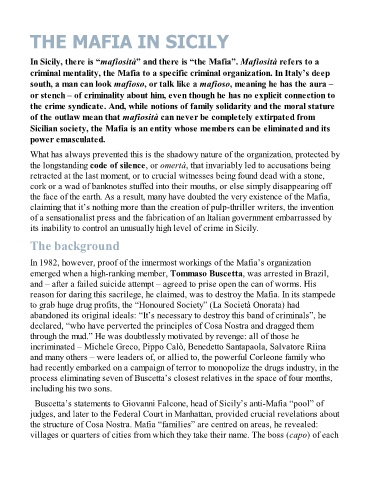Page 576 - The Rough Guide of Sicily
P. 576
THE MAFIA IN SICILY
In Sicily, there is “mafiosità” and there is “the Mafia”. Mafiosità refers to a
criminal mentality, the Mafia to a specific criminal organization. In Italy’s deep
south, a man can look mafioso, or talk like a mafioso, meaning he has the aura –
or stench – of criminality about him, even though he has no explicit connection to
the crime syndicate. And, while notions of family solidarity and the moral stature
of the outlaw mean that mafiosità can never be completely extirpated from
Sicilian society, the Mafia is an entity whose members can be eliminated and its
power emasculated.
What has always prevented this is the shadowy nature of the organization, protected by
the longstanding code of silence, or omertà, that invariably led to accusations being
retracted at the last moment, or to crucial witnesses being found dead with a stone,
cork or a wad of banknotes stuffed into their mouths, or else simply disappearing off
the face of the earth. As a result, many have doubted the very existence of the Mafia,
claiming that it’s nothing more than the creation of pulp-thriller writers, the invention
of a sensationalist press and the fabrication of an Italian government embarrassed by
its inability to control an unusually high level of crime in Sicily.
The background
In 1982, however, proof of the innermost workings of the Mafia’s organization
emerged when a high-ranking member, Tommaso Buscetta, was arrested in Brazil,
and – after a failed suicide attempt – agreed to prise open the can of worms. His
reason for daring this sacrilege, he claimed, was to destroy the Mafia. In its stampede
to grab huge drug profits, the “Honoured Society” (La Società Onorata) had
abandoned its original ideals: “It’s necessary to destroy this band of criminals”, he
declared, “who have perverted the principles of Cosa Nostra and dragged them
through the mud.” He was doubtlessly motivated by revenge: all of those he
incriminated – Michele Greco, Pippo Calò, Benedetto Santapaola, Salvatore Riina
and many others – were leaders of, or allied to, the powerful Corleone family who
had recently embarked on a campaign of terror to monopolize the drugs industry, in the
process eliminating seven of Buscetta’s closest relatives in the space of four months,
including his two sons.
Buscetta’s statements to Giovanni Falcone, head of Sicily’s anti-Mafia “pool” of
judges, and later to the Federal Court in Manhattan, provided crucial revelations about
the structure of Cosa Nostra. Mafia “families” are centred on areas, he revealed:
villages or quarters of cities from which they take their name. The boss (capo) of each

